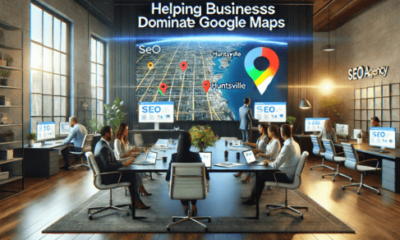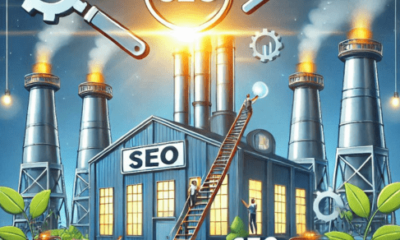Digital Marketing
From Clicks to Conversions: 8 Website Marketing Services That Fuel Business Growth

In today’s fast-paced digital landscape, simply having a website isn’t enough. To drive sustainable business growth, your site must attract the right audience, engage them effectively, and convert clicks into loyal customers. This is where website marketing services come into play. These services integrate data-driven strategies with creativity to ensure that your digital presence isn’t just seen—but that it delivers measurable results.
Let’s dive into eight powerful website marketing strategies and services that can help turn your website into a growth engine.
1. Search Engine Optimization (SEO)
Search Engine Optimization remains the backbone of most digital marketing strategies. Without organic traffic, even the most beautiful website won’t deliver results. According to SEO Agency Dallas, SEO ensures that your website ranks high in search engines, making it easier for potential customers to find your offerings when they’re searching for solutions.
To execute a strong SEO strategy, begin with keyword research using tools like Ahrefs, SEMrush, or Google Keyword Planner. Target a mix of short-tail and long-tail keywords relevant to your industry. Optimize your website’s metadata, URL structure, and content based on those keywords. Also, build backlinks from credible websites to enhance your domain authority.
Example: A local fitness studio optimized their blog with location-based keywords and structured their service pages to answer common search questions. Within three months, organic traffic increased by 60%.
2. Conversion Rate Optimization (CRO)
Driving traffic is only part of the puzzle. Conversion Rate Optimization focuses on improving the performance of your website by increasing the percentage of visitors who take desired actions—whether that’s making a purchase, filling out a contact form, or signing up for a newsletter.
Start by using tools like Google Analytics or Hotjar to study user behavior. Identify pages with high bounce rates or drop-offs. Test variations of those pages using A/B testing platforms like Optimizely or VWO—experimenting with elements such as headlines, button placements, colors, or calls-to-action.
Example: An eCommerce brand changed its product page layout to include customer reviews above the fold. The result? A 35% increase in completed purchases.
3. Content Marketing
Creating valuable, relevant content positions your brand as a thought leader and builds trust with your audience. A robust content marketing strategy can fuel SEO efforts and keep potential customers engaged as they move through the buying journey.
To get started, define your audience personas and understand their pain points. Then build a content calendar with blog posts, guides, videos, and infographics tailored to each stage of the funnel. Don’t forget to promote this content across your social and email channels for maximum visibility.
Example: A software company created a series of how-to articles targeting small business owners. This not only improved their SEO rankings but also generated qualified leads through downloadable templates embedded in each article.
4. Email Marketing Automation
Email marketing, when personalized and automated, can nurture leads over time and drive repeat purchases. It’s one of the highest ROI marketing channels when done correctly.
Start by segmenting your email list based on user behavior, preferences, or demographics. Use email marketing tools like Mailchimp, Klaviyo, or ActiveCampaign to set up automated workflows—such as welcome sequences, cart abandonment emails, or re-engagement campaigns.
Example: A fashion brand implemented an abandoned cart sequence that reminded users of unpurchased items. With just three automated emails, they recovered 20% of abandoned carts monthly.
5. Pay-Per-Click (PPC) Advertising
While SEO is a long-term strategy, PPC advertising delivers quick wins. Google Ads, Bing Ads, and social media platforms allow you to place your message in front of highly targeted audiences and control your budget with precision.
To launch an effective PPC campaign, first define your goals—be it leads, sales, or traffic. Conduct keyword research for search ads or create interest-based targeting for social ads. Write compelling ad copy, set up conversion tracking, and continually test and optimize for better performance.
Example: A SaaS startup used PPC to promote a free trial offer. After refining their keywords and ad copy, they reduced their cost-per-lead by 40% in just one month.
6. Social Media Marketing
Social media is no longer optional—it’s essential. It not only amplifies your content and builds brand awareness but also drives traffic and engagement. A well-crafted social media strategy ties directly into your overall digital marketing goals.
Begin by choosing the right platforms based on your audience. Create a content plan that mixes educational posts, promotional content, customer stories, and behind-the-scenes updates. Use scheduling tools like Buffer or Later, and track performance metrics to optimize your efforts.
Example: A home decor brand leveraged Instagram Reels to showcase before-and-after room transformations. This visual content drove a 50% increase in website visits and a notable uptick in product inquiries.
7. Website Analytics & Reporting
To continuously improve, you must measure what matters. Data is essential in understanding what’s working, what’s not, and where opportunities lie.
Use tools like Google Analytics, GA4, or HubSpot to set up dashboards that track your key performance indicators (KPIs). Monitor bounce rates, session durations, goal completions, and user paths. Use these insights to adjust your content, design, or targeting strategies accordingly.
Example: A B2B consulting firm discovered that visitors often dropped off their “About Us” page. By rewriting the copy to focus more on client results and testimonials, they saw a 22% increase in inquiries.
8. Integrated Website Marketing Services
While individual tactics are powerful, integrated website marketing services offer the greatest ROI. These services bundle multiple strategies—like SEO, PPC, content, and CRO—under one cohesive plan. This approach ensures all your digital touchpoints work together to convert visitors at every stage of the funnel.
Look for an agency or partner that understands your business goals and offers comprehensive website marketing services with clear reporting, regular strategy sessions, and measurable KPIs.
Example: A mid-sized eLearning company partnered with a full-service digital agency that handled their SEO, content, ads, and email. In under a year, they doubled their website leads and tripled their course enrollment rate.
Final Thoughts
Website marketing isn’t about chasing the latest trends—it’s about building a smart, scalable strategy that turns interest into action. Whether you’re refining your SEO, launching targeted PPC campaigns, or implementing email automation, each tactic plays a critical role in growing your business.
The key is integration, data-driven decisions, and a focus on the user journey. With the right website marketing services, your business won’t just get more clicks—it will get more conversions.
Let me know if you’d like this formatted into a downloadable blog post or adapted for a specific industry!

















You must be logged in to post a comment Login